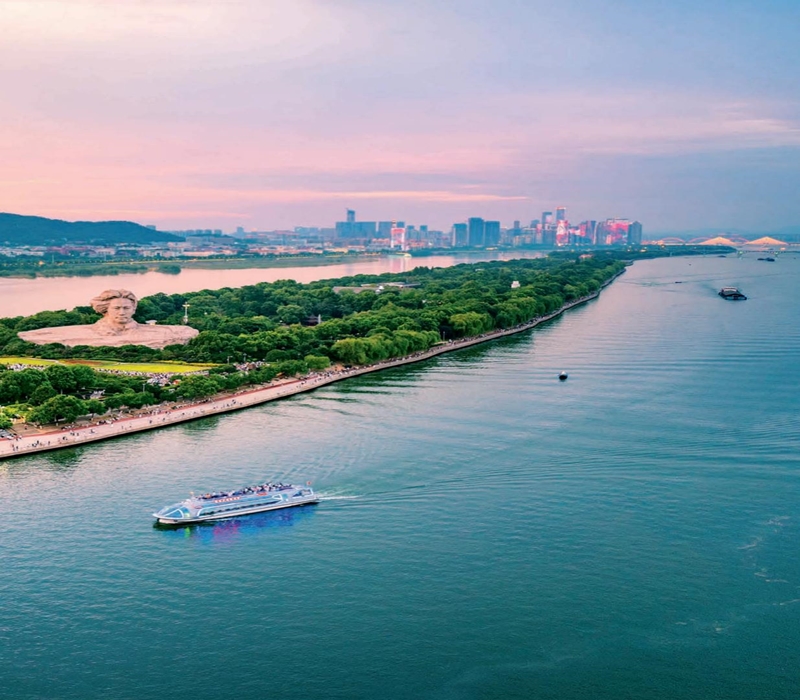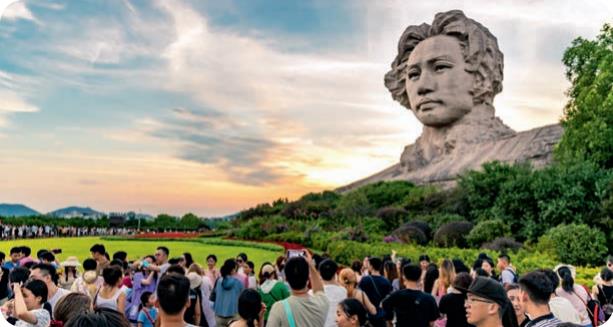Orange Isle on the Xiang jiang River

In late autumn 1925, 32-year-old Mao Zedong, one of the founders of the People’s Republic of China, stopped over on Orange Isle in Changsha along his journey from Hunan Province to Guangzhou. While gazing at the fiery red leaves on the Yuelu Mountain and the torrential water of the Xiangjiang River, he composed a poem eulogizing the autumn view of Changsha and expressing his revolutionary ideals. The poem ultimately won Orange Isle widespread fame.
Today, a 32-meter-tall statue of Mao Zedong, which was erected in December 2009, towers over Orange Isle. Facing southeast, the statue stares into the distance with a determined look, his hair swaying in the wind, as if he were pondering the fate of the nation and imagining the bright future of the country. The statue vividly depicts the remarkable vitality and revolutionary ambition of Mao Zedong in his youth, attracting numerous visitors to come to pay homage.
Nestled in the middle of the Xiangjiang River, Orange Isle faces Yuelu Mountain in the west and downtown Changsha to the east. Its name is derived from the abundant orange trees found growing there. Known as the “First Sandbank in China,” the isle stretches about five kilometers and covers an area of 74 hectares.
When he studied at Hunan First Public Normal School (present-day Hunan First Normal University), Mao Zedong often visited Orange Isle with close friends. They swam and strolled in the moonlight while sharing views on life and current affairs and expressing ambitions to transform China and the world. Over the past century, China has seen tremendous changes. Orange Isle has become a popular tourist attraction in Changsha. Many visitors flock there especially during holidays.

Orange Isle offers amazing views of the Yuelu Mountain, the Xiangjiang River, orange trees, and the Changsha skyline all year round. In spring, tender willows gently brush the banks and flowers are in full bloom, scenting the air with vitality and energy. All these make Orange Isle an ideal place for spring outings. In summer, orange trees provide shade and gentle breezes bring refreshing coolness. In autumn, ginkgo leaves turn golden, red maple leaves blaze like fire, and the branches of orange trees become draped with ripe fruits, all of which create a vibrant oil-painting. Even in winter, Orange Isle remains alluring. The “Snowy River at Dusk,” which has been listed among the “Eight Sights of Hunan” since the Northern Song Dynasty (960-1127), precisely refers to the gorgeous snow view on Orange Isle in winter. When the heavy snow falls, Orange Isle merges with the Xiangjiang River and the sky, and silence descends on everything. Combining the charm of nature, history, and modernity, Orange Isle provides a unique view of Changsha City.
Despite the vicissitudes of history, Orange Isle remains. Back in the Tang Dynasty (618-907), it was a grove abound with oranges. In the Northern Song Dynasty, it was famous for “Snowy River at Dusk.” In 1904, it witnessed the opening of Changsha Customs, and later, it became a cradle of early revolutionary activities of the Communist Party of China... Standing on an isle with such profound history and gazing at the blazing light of skyscrapers on both sides, one can feel the heartbeat of Changsha.